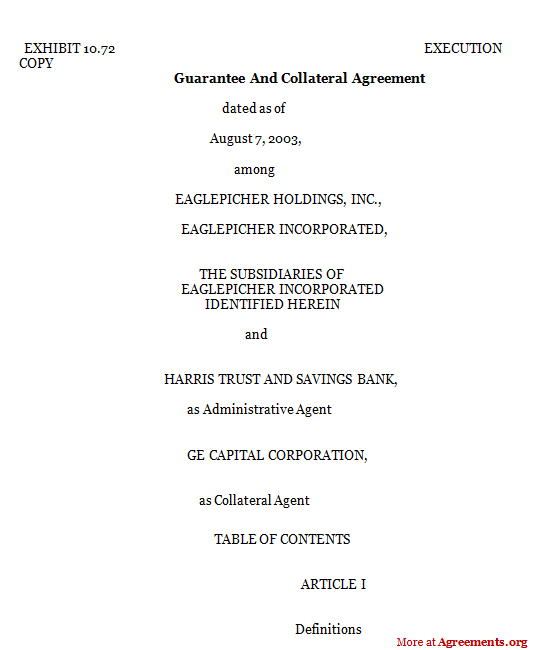A Guarantee and Collateral Agreement is a legal contract between the borrower, lender, and guarantor, where the borrower avails a loan for acquisition of an asset or performance of a similar act. This is a tripartite agreement between the borrower, the lender, and the guarantor. It is the responsibility of the guarantor to ensure that the loan is repaid if the borrower of the loan fails to meet the commitment.
The borrower is given the loan by the lender on the explicit understanding that the guarantor will assume the entire risk in case of default. The guarantor has to provide some collateral to the lender as security. This agreement is a pledge that is guaranteed by the guarantor.
When do you need a Guarantee and Collateral Agreement?
A Guarantee and Collateral Agreement is required when an individual or an entity requires a loan but is not in a position to provide collateral as security. The purpose of a Guarantee and Collateral Agreement is for the lender to ensure that the loan and the interest accrued thereon are paid on time and the risk of default in repayment by the borrower of the loan is minimised.
The guarantor is the third party that acts as collateral for the borrower and ensures that the loan commitment is honoured in full in the event of a default by the borrower. There are certain conditions which need to be fulfilled for the guarantor to take responsibility of repayment of the debt obligation on behalf of the borrower.
Inclusions in a Guarantee and Collateral Agreement
Given the fact that the Guarantee and Collateral Agreement is a tripartite agreement, it is mandatory for the names of the borrower, lender, and the guarantor to be included in the agreement. The Guarantee and Collateral Agreement must incorporate the effective date of the agreement, the total amount of loan being sanctioned, the rate of interest at which the loan is being provided, the repayment schedule, the nature of collateral being provided, the laws of the state under whose jurisdiction the agreement is made, limitation of liability, indemnity and the conditions under which the guarantor has to fulfil the repayment obligations of the borrower.
The events which lead to termination of the agreement will have to be clearly stated.
How to Draft a Guarantee and Collateral Agreement?
While drafting a Guarantee and Collateral Agreement, the following points need to be kept in mind:
- First and foremost, the names of the parties who are part of the agreement and the relationship between them needs to be clearly defined
- The financial guarantee from the third party or guarantor towards the borrower
- The agreement on the part of the guarantor to bear the responsibility of repayment of the loan or financial obligation
- The form in which the repayment of the loan can be made by the guarantor which could include goods or services
- The terms of repayment of the loan or debt being approved by the lender
- The events which lead to termination of the agreement
- Compliance with regard to the laws of the state
Benefits of a Guarantee and Collateral Agreement
Here are some of the benefits being provided by a Guarantee and Collateral Agreement:
- The interests of the borrower, guarantor, and lender are protected with this agreement. The lender is guaranteed the principal sum lent and the interest accrued.
- The conditions under which the guarantor will assume responsibility for the loan is also mentioned. This ensures that the borrower adheres to the duties and responsibilities laid out in the agreement.
Drawbacks of a Guarantee and Collateral Agreement
The drawbacks that a Guarantee and Collateral Agreement has are:
- The guarantor assumes all the risk in the agreement. Even though there are clauses in the agreement where certain conditions need to be fulfilled before the guarantor is responsible, but there is a lot of risk involved.
- The terms and conditions of such loans for borrowers are very stringent since the borrower requires a guarantor for the loan.
Types of Guarantee and Collateral Agreement
There are different types of Guarantee and Collateral Agreement:
- Absolute guarantee: The creditor can realise the dues under such agreements without any restrictions in the event the borrower defaults on any clause given in the contract.
- Conditional guarantee: Under this contract, mere default by the borrower does not give the lender the right to move for relief. The lender has to take certain actions before realising the dues
- Payment guarantee: There is a certain date given in such contracts which must be missed in order for the obligation to arise. After that date, it is the responsibility of the guarantor to honour the debt obligation.
Key terms in a Guarantee and Collateral Agreement
The key terms in a Guarantee and Collateral agreement are:
- Agreement of the guarantor to take responsibility for repayment of the loan
- The conditions under which the guarantor will accept the responsibility of repayment of the loan or debt obligation
- Compliance with laws of the state
- Rights and responsibilities of the borrower, lender and guarantor
- Amendments with respect to the borrower’s obligations
- Payment schedule which states the frequency of repayment of the debt obligation by the borrower or the guarantor as the case maybe
- The title of the collateral being provided by the guarantor must be clear
- Jurisdiction under which the agreement is valid and the governing law of the state
Download a Guarantee and Collateral Agreement
If you need to take a loan and require a guarantor for it, then a Guarantee and Collateral Agreement should be prepared.
You can download a sample Guarantee and Collateral Agreement here.

Download this USA Agreement of Limited Partnership for only $9.99
By clicking the button below, I agree with the Terms & Conditions.